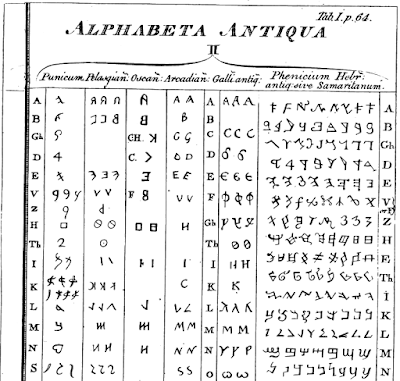There in the upper right-hand corner, at the left end of the string next to the "B" on the right edge, is the character that is the same as the number 2 in the Egyptian Counting document. There may be other sources as well, so if you run into any, please let me know.
This finding weakens my "smoking gun" for the influence of Moses Stuart's Hebrew book on the Kirtland Egyptian Papers, for this character could have been seen in Thomas Astle's book or some other source -- the fact that Moses Stuart's book was surely seen by Phelps and contains that character could just be coincidence and need not force the date of the Egyptian Counting document to after Hebrew books came to town in Kirtland.
On the other hand, while Astle’s 1784 book was in the Library of Congress by 1840 and at Harvard by 1830, and probably in other locations in the U.S., it does not show up in nineteenth century catalogs of several other major or relevant libraries that I have searched (e.g., the 1884 Princeton Library from Phelps’ home state, the Pennsylvania State library in 1859, the vast library at Allegheny College in New York in 1823, the Rochester Atheneum/City Library in 1839, Brown University in 1843, the Ohio State Library in 1875, and other major libraries, though it was in the Cincinnati Public Library by 1884), suggesting it may not have been a widely available book.
Thomas Astle's book is actually quite interesting and, like many books displaying archaic Greek alphabets and variants of Phoenician, allows one to recognize a number of characters quite similar to other non-Egyptian "Egyptian" in the Kirtland Egyptian Papers, perhaps due to influence of some Greek study among the brethren. That's a topic for a later post.
This post is part of a recent series on the Book of Abraham, inspired by a frustrating presentation from the Maxwell Institute. Here are the related posts:
- "Friendly Fire from BYU: Opening Old Book of Abraham Wounds Without the First Aid," March 14, 2019
- "My Uninspired "Translation" of the Missing Scroll/Script from the Hauglid-Jensen Presentation," March 19, 2019
- "Do the Kirtland Egyptian Papers Prove the Book of Abraham Was Translated from a Handful of Characters? See for Yourself!," April 7, 2019
- "Puzzling Content in the Egyptian Alphabet and Grammar," April 14, 2019
- "The Smoking Gun for Joseph's Translation of the Book of Abraham, or Copied Manuscripts from an Existing Translation?," April 14, 2019
- "My Hypothesis Overturned: What Typos May Tell Us About the Book of Abraham," April 16, 2019
- "The Pure Language Project," April 18, 2019
- "Did Joseph's Scribes Think He Translated Paragraphs of Text from a Single Egyptian Character? A View from W.W. Phelps," April 20, 2019
- "Wrong Again, In Part! How I Misunderstood the Plainly Visible Evidence on the W.W. Phelps Letter with Egyptian 'Translation'," April 22, 2019
- "Joseph Smith and Champollion: Could He Have Known of the Phonetic Nature of Egyptian Before He Began Translating the Book of Abraham?," April 27, 2019
- "Digging into the Phelps 'Translation' of Egyptian: Textual Evidence That Phelps Recognized That Three Lines of Egyptian Yielded About Four Lines of English," April 29, 2019
- "Two Important, Even Troubling, Clues About Dating from W.W. Phelps' Notebook with Egyptian "Translation"," April 29, 2019
- "Moses Stuart or Joshua Seixas? Exploring the Influence of Hebrew Study on the Grammar and Alphabet of the Egyptian Language," May 9, 2019
- "Egyptomania and Ohio: Thoughts on a Lecture from Terryl Givens and a Questionable Statement in the Joseph Smith Papers, Vol. 4," May 13, 2019
- "More on the Impact of Hebrew Study on the Kirtland Egyptian Papers: Hurwitz and Some Curiousities in the GAEL," May 20, 2019
- "He Whose Name Cannot Be Spoken: Hugh Nibley," May 27, 2019
- "More Connections Between the Kirtland Egyptian Papers and Prior Documents," May 31, 2019
- "Update on Inspiration for W.W. Phelps' Use of an Archaic Hebrew Letter Beth for #2 in the Egyptian Counting Document," June 16, 2019
- "The New Hauglid and Jensen Podcast from the Maxwell Institute: A Window into the Personal Views of the Editors of the JSP Volume on the Book of Abraham," July 1, 2019
- "The Twin Book of Abraham Manuscripts: Do They Reflect Live Translation Produced by Joseph Smith, or Were They Copied From an Existing Document?," July 4, 2019
- "Kirtland's Rosetta Stone? The Importance of Word Order in the 'Egyptian' of the Grammar and Alphabet of the Egyptian Language," July 18, 2019
- "The Twin BOA Manuscripts: A Window into Creation of the Grammar and Alphabet of the Egyptian Language?," July 21, 2019
- "A Few Reasons Why Hugh Nibley Is Still Relevant for Book of Abraham Scholarship," July 25, 2019
Continue reading at the original source →





